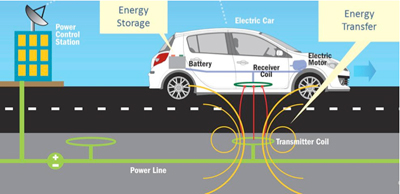Dealing with ‘range anxiety’: wireless highways to charge electric cars
March 27, 2012

Artist's rendering of a roadway embedded with magnetic coils that wirelessly charge electric vehicles cruising at highway speeds (credit: Stanford University)
Stanford University researchers are developing a system that allows electric cars to recharge while they are moving … via a recharging road, says BBC News.
“Range anxiety” is the term given to drivers of electric cars that are struck by the sudden fear that their vehicle does not have enough charge to reach its destination.
To help, firms such as Better Place have started building battery “switching stations” that allow drivers to pull in and swap their batteries as easily as filling up with gas. And engineers are developing a way to wirelessly charge electric cars from magnetic coils embedded in the road.
The system developed at Stanford works using a technique called “magnetic resonance coupling.” A coil in the road that is connected to a power line is made to vibrate with the same resonance frequency as the coil on the bottom of the car, allowing energy to flow between them.
It builds on pioneering work done at MIT in 2006 which showed the technique could be used in stationary situations, to power televisions and other gadgets. The Stanford researchers have come up with designs that allow 97% efficient transmission of power over a distance of about 2m (6ft). Using models, they estimate they can transfer up to 10kW of power.
Various firms, including an MIT spin-out called WiTricity, are already taking the first steps by building charging stations for car parks, garages and beyond.
On March 23, California Governor Edmund G. Brown Jr. announced plans for construction of a statewide network of charging stations for zero-emission vehicles (ZEVs), including at least 200 public fast-charging stations and another 10,000 plug-in units at 1,000 locations across the state.